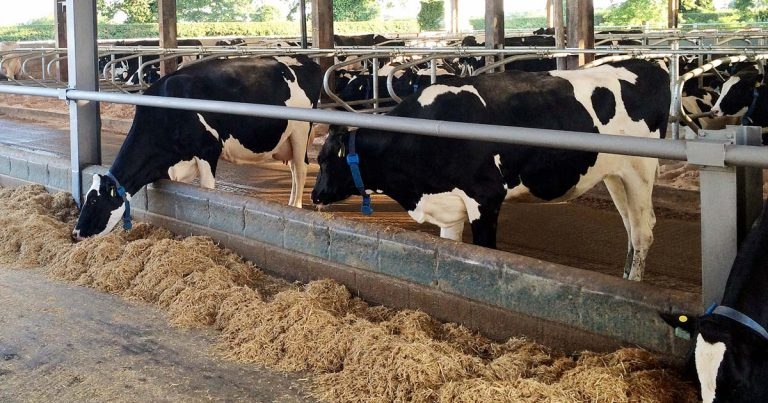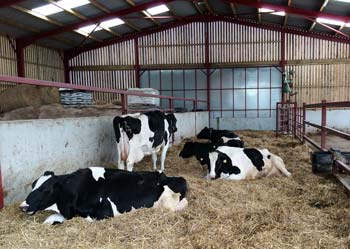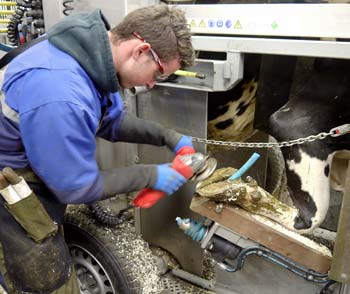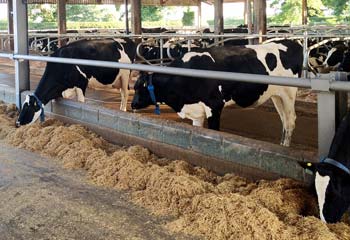8 May 2017
Owen Atkinson reviews various methods of maintaining dairy cow herd health during this process after milking.

Figure 3. Dry cows should have plenty of space, both for feeding and for moving around without conflict.
The dry period is an important part of a dairy cow’s production cycle.
Four main factors should be considered at drying off:

Increased focus has been made on the transition cow period, which should really encompass the whole dry period, including the transition from milking to dry. However, most people’s main attention is naturally towards the end of the dry period, ensuring a successful transition from dry to milking. This article specifically discusses the transition from milking to dry and the drying-off process.
Many of today’s high-yielding dairy cows will be producing in excess of 20L per day when dried off. This is a considerable amount of milk and the risk of leakage is significant, resulting in an open teat canal and a potential route of bacterial infection to the udder via the milk column. Even without leakage, the fact the teat canal is not being flushed twice a day during milking results in an increased risk of bacterial colonisation during the dry period (Figure 1).
The dry period is recognised as an important period for intramammary infections (IMIs), particularly with coliform bacteria (Green et al, 2002). These do not usually manifest as clinical mastitis at this time, but later during early lactation, when perhaps a reduction in the cow’s immunity precipitates a clinical mastitis episode.
It is best practice to dry off abruptly. Some farmers still practise once a day or every other day milking prior to drying off, but this should be discouraged as it increases the risk of IMI. After milking is stopped, intramammary pressure increases and milk products accumulate in the mammary gland. These inhibit further milk production. If the udder becomes congested, it may be tempting for a farmer to re-milk the cow. However, this practice stimulates further milk synthesis because intramammary pressure is reduced and prolactin is, once again, released. Re-milking may also remove protective white blood cells from the udder and slow the production of a protective waxy teat plug.
Drying off cows giving very high amounts of milk is a common problem that concerns farmers. In particular, as well as leaking milk, some cows show considerable discomfort from their distended udders. This is often cited by farmers as a reason for an intentional increase in calving interval (delayed first service), even though this leads to less economic efficiency.
Earlier in 2016, a product containing a prolactin inhibitor, cabergoline, was marketed for dairy cows – a similar product exists for inhibiting milk production in bitches with false pregnancy. This had great potential for helping farmers manage drying off their high-yielding cows, but, unfortunately, it has been temporarily suspended following reports of milk fever-like symptoms in some cows, predominantly in Denmark.
Alternatives to speed up the drying off process include putting the cow on to a very restricted diet, such as plain straw. Withdrawal of water, while sometimes practised, should never be encouraged.
Dry cow antibiotic therapy is one of five points of the original five-point mastitis control plan, which has been advocated since the 1960s and was developed by the National Institute for Research into Dairying (NIRD). The rationale for using intramammary antibiotics at drying off was two-fold:
In today’s sociopolitical and scientific climate, blanket use of antibiotics for prophylaxis goes very much against the grain. While antibiotics remain useful for treating some IMIs, which is part of good cell count management, little justification exists for their use in non-infected cows when perfectly good alternative strategies are available.
Internal teat sealants are widely used and good evidence exists they reduce the risk of new IMIs during the dry period, which, in turn, reduces clinical mastitis rates in early lactation (Huxley et al, 2002). Evidence suggests sealants by themselves can be more effective than either antibiotics by themselves, or a combination of antibiotics and sealants, in reducing new IMIs, particularly Gram-negative infections (Bradley et al, 2010). Antibiotics, by disturbing the natural balance of protective skin commensals, may themselves be a risk factor for new IMIs. This might provide a convincing argument than for the use of sealants alone in non-infected (low-cell count) cows.
This is the concept of “selective dry cow therapy”, where a risk-based approach is used to select cows suitable for dry cow antibiotics plus sealant, and others for sealant alone. The risks are based on cell count history of the farm and the individual cow, individual clinical mastitis history, and training and competence of the person charged with doing the drying off.
In reality, most farmers who use sealants still do so in conjunction with antibiotic therapy. This is despite the additional costs of double tubing and the potential benefits of dropping the antibiotic where it is not required.
The main reasons the author experienced for some farmers persisting with double tubing seem to be:
Certainly, sealants do need to be inserted very cleanly and carefully if iatrogenic infection is to be avoided. Selective dry cow therapy isn’t exactly rocket science, but it does require a certain change in mindset and modifications of teat preparation and tube insertion technique. Not all farmers will have the capability, let alone the will.
Retailer groups have thrown down the challenge to vets and farmers to reduce the unnecessary blanket use of dry cow antibiotics. The author’s view is this creates opportunities for vets willing to rise to the challenge and believes they will find a largely open-minded group of farmers once the science, economics and practicalities are discussed.
Inevitably, a more intransigent group will take a “if it ain’t broke, don’t fix it” mentality. Indeed, some of these farmers may only just have switched on to using dry cow antibiotics as part of the five-point plan in the first place. Perhaps farmers to watch out for are those who take a rather “gung-ho” approach and tackle selective dry cow therapy without training or understanding the principles – or those who simply stop using antibiotics, don’t use sealants and risk a chronic high-cell count problem. It is catering for this wide diversity of farmers that makes our job interesting.
Cows should be dried off with a BCS from 2.5 to 3.5. At least, this is the recommended range for Holsteins – other breeds, such as Friesians, may be fine at slightly higher BCS. Overconditioned cows are at higher risk of metabolic disease during the next lactation; for example, ketosis, low dry matter intakes and consequent severe negative energy balance (Drakley et al, 2006).
It is a risky strategy to try to get cows to lose weight during the dry period. In any case, it is not easy to do as their energy requirements are low during this period, which is met by a very poor diet. If a low energy diet can be combined with exercise, it might be possible to slim cows down in the early dry period. However, as encouraging fat mobilisation is not a good idea towards the end of pregnancy, weight loss should be actively avoided in the final six weeks of the dry period.
A better strategy is to ensure cows are not over-fat before drying off. Overfeeding of late lactation cows can be a common problem, particularly if they have long lactations due to poor fertility efficiency. This can become a vicious cycle on some farms: fat cows at drying off → excess weight loss in early lactation → poor fertility and delayed days to conception → long lactation → fat accumulation in late lactation and over-fat at next drying off.
A strong economic argument is often used for not serving cows beyond, say, 200 days into lactation, but to let them exit the herd as fat barren cows at the end of their lactation. This can prevent the vicious cycle and focus farmers’ minds to ensure the cows do indeed become pregnant by day 200. Some farms have a late lactation “fat-cow” group on a lower energy diet in an attempt to prevent over-fat cows at drying off. In the author’s experience, this often has limited success and is usually unpopular with farmers because it is another (small) group to house and feed separately.

The opposite end of the scale, too thin (below BCS 2.5), is just as important to avoid. Some very high-yielding herds can fall into this trap, farmers being overcautious, perhaps, to avoid fat cows, which they know is important, but not being quite so aware of the dangers of over-thin cows.
Cows with low BCS at drying off and calving have a higher risk of lameness in the following lactation (Machado et al, 2010). The reason is thought to be due to less protective cushioning in the foot by the digital cushion fat pad. This is a comparatively new finding and an area of research, and, for those interested in reducing cow lameness, it offers very exciting possibilities. In particular, managing appropriate fat pad cushioning is protective for the claw horn lesions: sole haemorrhage, sole ulcers and white line disease.
It is encouraging farmers seem to have cottoned on to this research very quickly, which is testament to the excellent extension work done by Agriculture and Horticulture Development Board Dairy, as well as individual vets spreading the word.
Many dairy cows have a routine foot trim prior to drying off (Figure 2). The rationale is the cow should calve down with a correct foot shape. In particular, long toes and overgrown sole horn of outer hind claws can both increase the risk of pressure on the corium, leading to contusion and claw horn lesions. The peri-calving period is naturally a high risk time for foot health and this is, in part, due to poorer suspension of the pedal bone within the hoof (Tarlton et al, 2002). Metalloproteinases under the influence of relaxin, released when oestrogen is high around calving, weaken the laminae bonds and the pedal bone slightly sinks, putting pressure on the corium responsible for sole horn production.
In addition to ensuring correct hoof shape, a pre-drying off foot check allows treatment of chronic, but low-grade, digital dermatitis lesions. This might reduce the risk of flare up of more acute and painful lesions after calving. However, the author advocates regular foot bathing during the dry period in addition to this. The dry period can be a time of “benign neglect” and digital dermatitis, left uncontrolled, can become a real problem in dry cows. This will not lead to a good start to lactation. A firm evidence base is lacking, however, on the most effective control strategies for digital dermatitis, and much of the advice vets give is based on anecdote or “perceived wisdom”.
Cows are social animals. Herd social dynamics are complex – again, this is an area we do not fully understand. What is known is whenever a cow moves from one group to another, not only her own feeding pattern, but the feeding behaviour of the whole group, is disrupted (von Keyserlingk et al, 2008).
The general advice is to avoid moving cows between groups where possible, to allow a stable hierarchy to develop. When cows are moved, which almost inevitably happens at drying off, it is better to move them at least in pairs (Nordlund et al, 2006). Farmers should avoid drying off cows in ones or twos on a very frequent basis.
Depending on herd size, a better approach may be to have a fixed day per week when drying off occurs. This can have two benefits:
Even despite these measures, it is common for farmers to report bullying and fighting when new dry cows are added to an established dry cow group. This is a risk for abortion, as well as slips and injuries. Besides, the stress for the cows is presumably not pleasant and if we can reduce this we will better protect their welfare.

Housing design and cow space can influence how well cows might be expected to cope with the stress of new social groups. Dead ends in cubicle sheds, narrow passageways and slippery floors should all be avoided (Figure 3). Feed space should be at least 75cm per cow during the dry period. Shed space should ideally be at least 1m² per 1,000L milk production, including cubicles. For straw yards, an additional 0.3m²/1,000L milk production should be made for loafing areas – the larger area for straw yard-housed cows is to mitigate the increased risks of mastitis.
Other stressors might also be considered; for example, avoiding dogs and having well-designed handling facilities for routine procedures, such as administering vaccines or boluses, performing foot-checking or during TB testing. Regular handling of dry cows can be a good thing, particularly when heifers are being acclimatised to the adult group. Cows like routine and are very comfortable with human contact when it is regular, calm and gentle.
Good stock handling is something we may assume farmers and their staff innately know. Certainly, good stockmanship skills can be passed down from generation to generation and excellent examples exist on farms. Some appalling examples of stockmanship also exist, largely through ignorance rather than inherent unkindness, and this is another area where vets can bring value to their clients; not only in training, but in design of handling facilities and protocols.
Drying cows off is not something vets have been accustomed to thinking about too much. Perhaps the clear veterinary involvement in selective dry cow therapy, as well as discussion around selective use of monensin boluses for dry cows, has brought us in closer contact with this aspect of dairy farm management.
Plenty of considerations and opportunities are available for farm vets around drying off practices. This article has hopefully explored them a little.